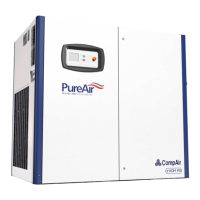5. Transport and installation
24
5 Trans port an d instal lation
5.1 Transport
Fig. 7
Fig. 8
Note
Before transporting the unit, remove the doors. The
doors must be removed before lifting from the control
side. In addition the safety plate (-1- Fig. 8) must be
removed before lifting from the back.
Danger
The compressor must be lifted using a suitable
forklift truck which complies with the local safety
regulations.
The length of the forks must correspond at least to
the width of the unit (see Chapter 11.2).
Before lifting, all loose or slewable parts of the
machine have to be firmly secured.
It is strictly prohibited to work or stand in the
danger zone of a lifted load.
The proper lifting of the load (according to the
operating instructions of the load suspension
device) has to be ensured.
Important
Never lift or lash the compressor and its hood via
the enclosure. The screw compressor is lifted with
the help of a fork lift truck (11.2). The separation
of the forks and their length must be taken into
account for transportation.
Only use the identified lifting points. Do not slide
the unit when it is standing on the floor.
Weights
The values listed below are approximate values, they
refer to a screw compressor unit including water fill:
water-cooled D110H RS-W: 2200 kg
water-cooled D75H RS-W 1810 kg
air-cooled D75H RS-A 1890 kg
water-cooled D50H RS-W 1490 kg
air-cooled D50H RS-A 1570 kg

